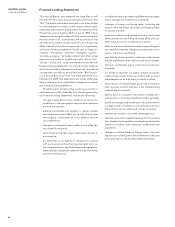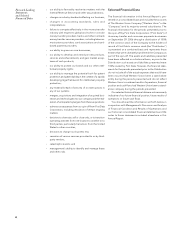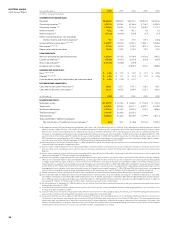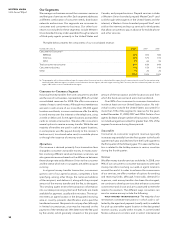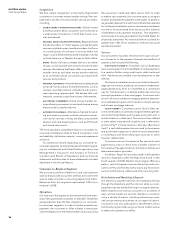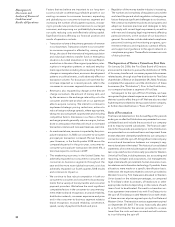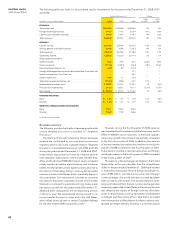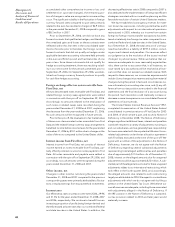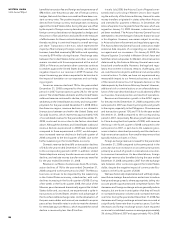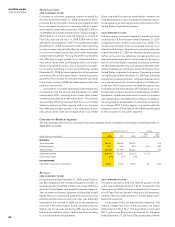Western Union 2008 Annual Report Download - page 20
Download and view the complete annual report
Please find page 20 of the 2008 Western Union annual report below. You can navigate through the pages in the report by either clicking on the pages listed below, or by using the keyword search tool below to find specific information within the annual report.WESTERN UNION
2008 Annual Report
18
Certain expenses related to being a stand-alone com-
pany, reflected in the consolidated statements of income,
are higher than the historical amounts prior to the spin-off.
The financial information presented in this Annual Report
on Form 10-K prior to the spin-off date of September 29,
2006 does not reflect what our consolidated financial posi-
tion, results of operations or cash flows would have been
as a stand-alone company during the periods presented
and is not necessarily indicative of our future consolidated
financial position, results of operations or cash flows.
Subsequent Event
In February 2009, we entered into an agreement to acquire
the money transfer business of European-based FEXCO,
one of our largest agents providing services in the United
Kingdom, Spain, Ireland and other European countries.
Prior to the acquisition, we hold a 24.65% interest in FEXCO
Group Holdings (FEXCO Group), which is a holding com-
pany for both the money transfer business as well as various
unrelated businesses. We will surrender our 24.65% interest
in FEXCO Group and pay €123.1 million (approximately
$160 million based on currency exchange rates at deal
signing) as consideration for the overall money transfer
business. The acquisition is expected to close in the first half
of 2009, subject to regulatory approvals and satisfaction
of closing conditions. The acquisition will be recognized
at 100% of the fair value of the money transfer business,
which will exceed the cash consideration of €123.1 million
given the non-cash consideration conveyed via the sale of
our interest in FEXCO Group. The fair value of the money
transfer business will be determined upon closing and is
subject to fluctuation due to changes in exchange rates
and other valuation inputs.
Adoption of Accounting Standards
Statement of Financial Accounting Standards
(“SFAS”) No. 157
Effective January 1, 2008, we determine the fair market
values of our financial assets and liabilities, as well as
non-financial assets and liabilities that are recognized or
disclosed at fair value on a recurring basis, based on the
fair value hierarchy established in SFAS No. 157, “Fair
Value Measurements” (“SFAS No. 157”). The standard
describes three levels of inputs that may be used to mea-
sure fair value.
ºLEVEL 1: Quoted prices in active markets for identical
assets or liabilities. Western Union’s financial instru-
ments that base fair value determinations on Level 1
inputs are not material.
º
LEVEL 2:
Observable inputs other than Level 1 prices
such as quoted prices for similar assets or liabilities;
quoted prices in markets that are not active; or other
inputs that are observable or can be corroborated by
observable market data for substantially the full term
of the assets or liabilities. Most of our assets and liabili-
ties fall within Level 2 and include state and municipal
debt instruments, other foreign investment securities,
and derivative assets and liabilities. We utilize pricing
services to value our Level 2 financial instruments.
For most of these assets, we utilize pricing services
that use multiple prices as inputs to determine daily
market values.
º
LEVEL 3: Unobservable inputs that are supported by
little or no market activity and that are significant to
the fair value of the assets or liabilities. Level 3 assets
and liabilities include items where the determination of
fair value requires significant management judgment
or estimation. We currently have no Level 3 assets or
liabilities that are measured at fair value on a recur-
ring basis.
Pursuant to the Financial Accounting Standards Boards
(“FASB”) Staff Position No. 157-2, “Effective Date of FASB
Statement No. 157” (“FSP No. 157-2”), the effective date
of SFAS No. 157 for certain non-financial assets and liabili-
ties that are measured at fair value but are recognized or
disclosed at fair value on a non-recurring basis has been
deferred to fiscal years beginning after November 15, 2008.
We are primarily impacted by this deferral as it relates to
non-financial assets and liabilities initially measured at fair
value in a business combination (but not measured at fair
value in subsequent periods) and fair value measurements
in impairment testing. We adopted these remaining pro-
visions of SFAS No. 157 effective January 1, 2009. We do
not expect the impact to be significant on our financial
position, results of operations and cash flows.
Due to the nature of our investment securities, there
have been no material changes to our valuation techniques
during the year ended December 31, 2008.
FASB Interpretation No. 48
We adopted the provisions of the FASB Interpretation No.
48, “Accounting for Uncertainty in Income Taxes” (“FIN 48”),
on January 1, 2007. FIN 48 addresses the determination of
how tax benefits claimed or expected to be claimed on a
tax return should be recorded in the consolidated financial
statements. Under FIN 48, we recognize the tax benefits
from an uncertain tax position only when it is more likely
than not, based on the technical merits of the position,
that the tax position will be sustained upon examination,
including the resolution of any related appeals or liti-
gation. The tax benefits recognized in the consolidated
financial statements from such a position are measured
as the largest benefit that has a greater than fifty percent
likelihood of being realized upon ultimate resolution. As a
result of the implementation of FIN 48, we recognized an
increase in our liability for unrecognized tax benefits plus
associated accrued interest and penalties of $0.6 million,
which was accounted for as a reduction to the January 1,
2007 balance of retained earnings.
Refer to “Note 10—Income Taxes” in our historical con-
solidated financial statements for a more detailed discus-
sion of the adoption of FIN 48.
Components of Revenue and Expenses
The following briefly describes the components of revenue
and expenses as presented in the consolidated statements
of income. Descriptions of our revenue recognition policies
are included in Note 2—“Summary of Significant Accounting
Policies” in our consolidated financial statements.
TRANSACTION FEES —
Transaction fees are charged for
sending money transfers and consumer-to-business pay-
ments. Consumer-to-consumer transaction fees generally
vary according to the principal amount of the money
transfer and the locations from and to which the funds
18


